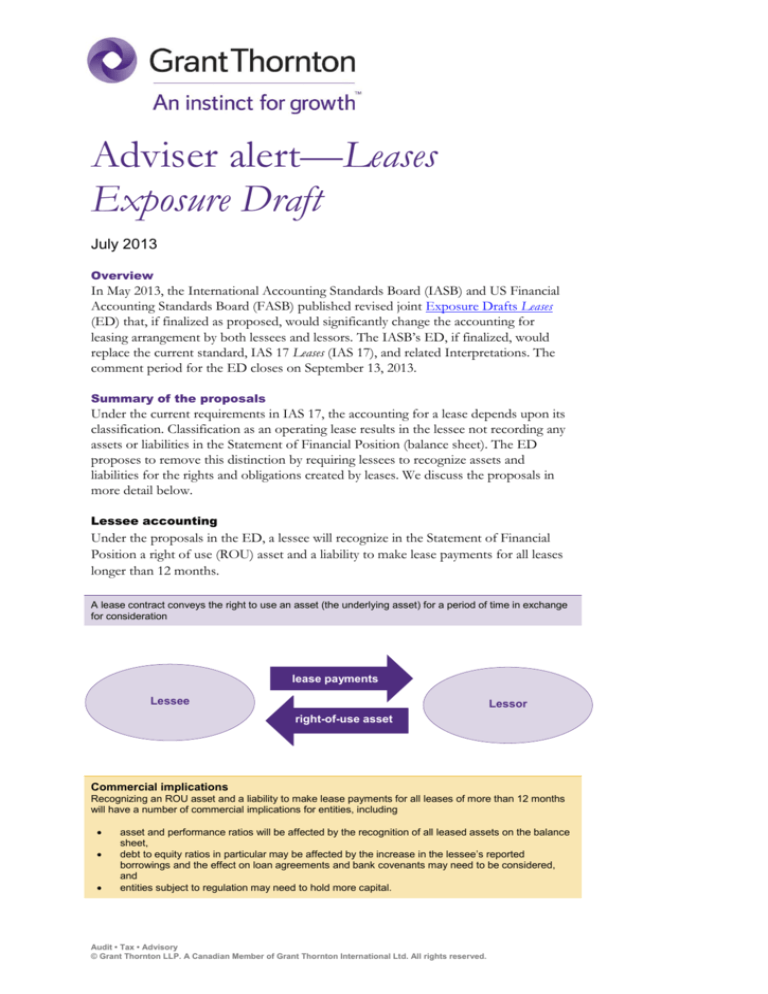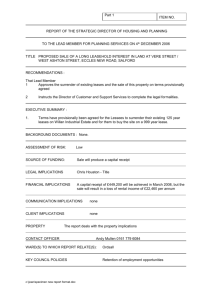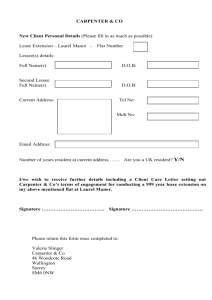
Adviser alert—Leases
Exposure Draft
July 2013
Overview
In May 2013, the International Accounting Standards Board (IASB) and US Financial
Accounting Standards Board (FASB) published revised joint Exposure Drafts Leases
(ED) that, if finalized as proposed, would significantly change the accounting for
leasing arrangement by both lessees and lessors. The IASB’s ED, if finalized, would
replace the current standard, IAS 17 Leases (IAS 17), and related Interpretations. The
comment period for the ED closes on September 13, 2013.
Summary of the proposals
Under the current requirements in IAS 17, the accounting for a lease depends upon its
classification. Classification as an operating lease results in the lessee not recording any
assets or liabilities in the Statement of Financial Position (balance sheet). The ED
proposes to remove this distinction by requiring lessees to recognize assets and
liabilities for the rights and obligations created by leases. We discuss the proposals in
more detail below.
Lessee accounting
Under the proposals in the ED, a lessee will recognize in the Statement of Financial
Position a right of use (ROU) asset and a liability to make lease payments for all leases
longer than 12 months.
A lease contract conveys the right to use an asset (the underlying asset) for a period of time in exchange
for consideration
lease payments
Lessee
Lessor
right-of-use asset
Commercial implications
Recognizing an ROU asset and a liability to make lease payments for all leases of more than 12 months
will have a number of commercial implications for entities, including
asset and performance ratios will be affected by the recognition of all leased assets on the balance
sheet,
debt to equity ratios in particular may be affected by the increase in the lessee’s reported
borrowings and the effect on loan agreements and bank covenants may need to be considered,
and
entities subject to regulation may need to hold more capital.
Audit • Tax • Advisory
© Grant Thornton LLP. A Canadian Member of Grant Thornton International Ltd. All rights reserved.
2
Initial measurement
The ROU asset and the liability to make lease payments are recognized at the date the
underlying asset is made available to the lessee. The liability is initially measured as the
present value of lease payments discounted using the rate charged by the lessor or, if
this is not available, the lessee's incremental borrowing rate. To determine the lease
payments, an entity will first have to determine the lease term. The lease term will
include any optional period to extend the lease, if there is a significant economic
incentive for the lessee to exercise the option.
Once the lease term is calculated, the entity will then need to review the lease payments
to determine those that are to be included in the initial recognition of the lease liability.
The liability will include
fixed payments,
variable payments that depend on an index or rate,
variable payments that are in substance fixed payments, and
amounts expected to be paid under residual value guarantees and the exercise price
of extension/termination options if there is a significant economic incentive for the
lessee to exercise those options.
Having determined the initial measurement of the liability, the initial measurement of
the ROU asset is simply the value of the liability plus any initial direct costs incurred by
the lessee plus any payments made to the lessor at or before the commencement of the
lease less any lease incentives.
Lease liability
Right of use asset
(at cost)
(present value of
lease payments)
Subsequent measurement
The dual approach
Unlike the 2010 ED, the new ED does not apply a single lessee accounting model but
instead applies a dual approach for lease expenses. This dual approach determines the
subsequent accounting for the recognition of the lease expense.
The principle for determining which approach to apply is based on the consumption of
the underlying asset. This reflects the IASB’s view that there is a difference between a
lease for which the lessee pays for consuming a significant part of the underlying asset
during the lease term, and a lease for which the lessee merely pays for using the asset.
The ED applies this concept in a simplified way, distinguishing between “Type A” and
“Type B” leases. This determination will depend on whether or not the lease is a real
estate (property) lease, on the basis that for most leases of real estate the lessee merely
uses the underlying asset without consuming more than an insignificant part of it. By
way of contrast, the ED asserts that a lessee typically consumes a significant part of any
equipment or vehicle that it leases.
Audit • Tax • Advisory
© Grant Thornton LLP. A Canadian Member of Grant Thornton International Ltd. All rights reserved.
3
Lease classification test
Leases for equipment/
vehicles are Type A unless
Leases for real estate are
Type B unless
lease term is insignificant
relative to total economic
life of asset, or
present value of lease
payments is insignificant
relative to fair value of
asset.
lease term is a major part of
the remaining life of asset,
or
present value of lease
payments is substantially all
of fair value of asset.
After initial recognition, the liability for lease payments is accounted for at amortized
cost subject to certain adjustments, while the ROU asset is recognized at cost less
accumulated amortization and impairment. Classification of the lease as either Type A
or Type B affects both the calculation and the presentation of the lessee's lease expense.
Type A leases
For Type A leases, a finance charge for the unwinding of the discount on the lease
liability will be recognized separately from an amortization charge for the ROU asset.
The unwinding of the lease liability will be measured using the effective interest
method. The ROU asset will be amortized on a straight line basis unless another basis is
more representative of the pattern in which the lessee expects to consume the ROU
asset's future economic benefits. As a result, the lessee's total cost for a Type A lease
will be higher in the earlier years of the lease and lower in later years (so-called “front
loading”). Most current non-property operating leases are expected to become Type A
leases.
Type B leases
Type B leases will result in a straight-line total lease cost in each year of the lease. The
total lease cost will combine both the unwinding of the discount on the lease liability
and the amortization of the ROU asset. The unwinding of the discount on the lease
liability will be calculated using the effective interest method. The amortization of the
ROU asset will be a balancing figure to ensure the total lease expense is recognized
straight line over the lease term.
Lessee accounting overview
Statement of
Financial
Position
Type A
Most leases
of equipment
/vehicles
Type B
Most leases
of real estate
Right-of-use
asset
Lease
liability
Right-of-use
asset
Lease
liability
Income
statement
Amortisation
expense
Interest
expense
asset
Single
lease
Lease liability
expense on
a straightline basis
Audit • Tax • Advisory
© Grant Thornton LLP. A Canadian Member of Grant Thornton International Ltd. All rights reserved.
Cash flow
statement
Principal
Interest
Single
lease
payments
4
Lessor accounting
For practical purposes, the ED would have only a minor impact on the accounting by
lessors for finance leases. Under IAS 17, lessors recognize a lease receivable and
derecognize the underlying asset. These leases would be Type A under the proposed
model and lessors would apply the “receivable and residual” model described below.
However, the residual asset would be relatively small.
For leases that are considered operating leases under IAS 17, the extent of change
would depend on whether the underlying asset is property or equipment. A lessor
would distinguish between most property and most equipment leases in the same way
that a lessee would under the proposals. Operating leases of property would be Type B
leases and the proposed lessor accounting model would be essentially unchanged.
Operating leases of equipment or vehicles would typically be Type A and, for these, the
changes proposed are significant.
A lessor of most equipment or vehicles leases would apply the “receivable and residual
approach” and would:
a) recognize a lease receivable and a retained interest in the underlying asset (the
residual asset), and derecognize the underlying asset; and
b) recognize interest income on both the lease receivable and the residual asset over
the lease term.
A manufacturer or dealer lessor might also recognize profit on the lease when the
underlying asset is made available for use by the lessee.
Lessor accounting overview
Type A
Most leases
of equipment
/vehicles
Statement of
Financial
Position
Lease
receivable
Income
statement
Interest income and
any profit on the lease
Residual asset
Type B
Most leases
of real estate
Continue to
report asset
being leased
Rental income
Exceptions
The ED would permit simplified accounting for short-term leases, defined as leases
where the maximum possible term (including any option periods) is 12 months or less.
For such leases, an entity may elect on a class by class basis to account in essentially the
same way as for operating leases in accordance with IAS 17.
The ED also proposes a number of scope exceptions that are broadly in line with IAS
17's (for example, leases of intangible assets and leases to explore for or use mineral
resources and similar non-regenerative resources).
Audit • Tax • Advisory
© Grant Thornton LLP. A Canadian Member of Grant Thornton International Ltd. All rights reserved.
5
The link between the leasing model and IAS 40 Investment Property (IAS 40) also remains
important. Under the ED
A lessee would be obliged to apply IAS 40 in measuring ROU assets that are
investment property, and can choose IAS 40's cost or fair value model. This would
change the current position under which a lessee with an operating lease interest in
investment property can choose to apply IAS 40 but must use fair value if it does.
A lessor that owns an investment property and leases it under a Type B lease would
apply IAS 40 to the asset.
Disclosures
The proposed Standard sets out extensive numerical and narrative disclosure
requirements for both lessees and lessors designed to enable users of the financial
statements to understand the amount, timing and uncertainty of cash flows arising from
leases.
Transition
The ED proposes what is referred to as a modified retrospective approach. Entities
applying the modified retrospective approach would use certain shortcut calculations to
initially measure lease-related assets and liabilities. They also would be able to use
hindsight to determine the lease term or whether an existing arrangement contains a
lease. Entities will adjust the statement of financial position at the beginning of the
earliest comparative period presented, as if the entity had always applied the proposed
Standard.
For finance leases existing at the date of initial application, lessees and lessors will be
permitted to use the existing carrying amounts of lease-related assets and liabilities as
the initial measurements under the proposal.
Resources
Exposure Draft ED/2013/6 Leases
Audit • Tax • Advisory
© Grant Thornton LLP. A Canadian Member of Grant Thornton International Ltd. All rights reserved.
About Grant Thornton
in Canada
Grant Thornton LLP is a
leading Canadian
accounting and advisory
firm providing audit, tax
and advisory services to
private and public
organizations. Together
with the Quebec firm
Raymond Chabot Grant
Thornton LLP, Grant
Thornton has
approximately 4,000
people in offices across
Canada. Grant Thornton
LLP is a Canadian
member
of Grant Thornton
International Ltd,
whose member firms
operate in close to 100
countries worldwide.
The information in this
publication is current as
of July 30, 2013.
We have made every
effort to ensure
information in this
publication is accurate as
of its issue date.
Nevertheless, information
or views expressed
herein are neither official
statements of position,
nor should they be
considered technical
advice for you or your
organization without
consulting a professional
business adviser. For
more information about
this topic, please contact
your Grant Thornton
adviser. If you do not
have an adviser, please
contact us. We are happy
to help.




